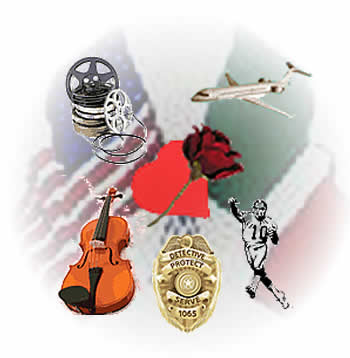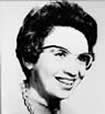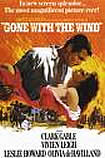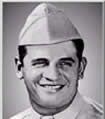
|

|

|
||||||
|
|
People You Should Know
Here is a small sampling of Americans whose achievements
in various fields of American life
have been overshadowed by gangster and buffoon stereotypes.
|
 (Biographies provided courtesy of The Italic Institute of America, www.italic.org)
(Biographies provided courtesy of The Italic Institute of America, www.italic.org)
|
| Business | |
|
Helen Boiardi
An entrepreneur, she and her husband Hector turned from their Cleveland restaurant business to producing a line of canned pasta during the 1930s. So customers could pronounce their family name, she chose the phonetic spelling "Boy-ar-Dee." |
William Cafaro
A mall developer from Youngstown, Ohio, he was a pioneer, along with Edward DeBartolo, of the American shopping mall. Cafaro began his career in the '40s. Today, his company, The Cafaro Company, is among the ten largest commercial real estate companies in the nation. His estimated wealth in 1998 was $800 million. |
|
Edward DeBartolo
A real estate tycoon who, after serving in WWII and the Korean War as an army engineer, took advantage of the postwar growth of suburbia. His philosophy of building shopping centers in the country helped change the way America shopped. Known for his 13-hour, seven day a week work habit, DeBartolo donated $33 million to Notre Dame and purchased the championship San Francisco 49ers, which are still in his family. |
James Cantalupo

CEO of McDonald's Corporation. Before his untimely death of a heart attack at age 61, Cantalupo oversaw McDonalds' expansion into the largest fast-food operation in the world. |
|
Education |
|
|
Dr. Leo Buscaglia
Prolific author, lecturer and college professor, Dr. Buscaglia made America a "kinder and gentler" nation by teaching people how to express their feelings and emotions. |
Anne Anastasi
 Brilliant, passionate and largely self-educated Fordham University
psychology professor.
Dr. Anastasi was the first to analyze cultural biases
in standardized intelligence tests across the nation.
Brilliant, passionate and largely self-educated Fordham University
psychology professor.
Dr. Anastasi was the first to analyze cultural biases
in standardized intelligence tests across the nation.
|
|
Entertainment |
|
Don Ameche
 Film star Dominic Felix Amici died in 1992 at age 85. This handsome actor took the lead in some 40 feature films including The Story of Alexander Graham Bell and Cocoon. |
Sonny Bono
Talented and versatile composer, vocalist, entrepreneur and political activist died tragically in a skiing accident. Bono, born of Sicilian parents, broke into the music business as a singer/meat delivery driver who caught the attention of some music executives. Ten of his recordings with singing partner Cher went gold. Among his hits were Needles and Pins (for the Searchers), Baby Don't Go, I Got You Babe and The Beat Goes On. In 1994 he was elected to Congress as a Republican from California, where he gained the respect of his colleagues for his pragmatic and satirical criticism of Congressional antics. |
Peter Comandini

Pioneered film restoration techniques. Among his credits are Gone with the Wind. |
Ida Lupino
One of the first independent female film directors in Hollywood (1950s). Lupino's family was descended from a long line of Italian theater actors who had originally emigrated to London. |
|
Journalism |
|
|
Lou Cioffi
A television journalist who covered the Korean War, the Vietnam War and the Iran Hostage Crisis for CBS and ABC. |
Marie Torre
One of the first journalists to go to jail for refusing to reveal a news source (1959). |
Annibale Luigi Paragallo

Also known as Luis Marden, he was the Renaissance man behind National Geographic Magazine. From 1934 into the 1990s, Marden was a photographer, writer, editor and explorer who pioneered the use of underwater and 35mm color photography. |
|
|
Law Enforcement |
|
|
Livio Boccaccio
Police training specialist killed in a UN helicopter crash in Bosnia during a tour to revive local police forces in a war-ravaged country. Prior to his death, Boccaccio was on the training staff of the FBI Academy in Quantico, Virginia, where he provided training to 1,000 police officers per year. A very competitive man with a quick sense of humor, he was once surprised by a class of 270 men who donned masks with his likeness. "I've been here 15 years," said Mr. Boccaccio without pause, "and I must tell you that this is the best looking class that's ever come through the academy." |
Robert C. Belloni
Former justice of the U.S. District Court. Belloni was the first to uphold Indian fishing rights in the Pacific Northwest. His ruling in the landmark case Sohappy vs. Smith was an historic precedent in recognition of dispossesed Native Americans. He ruled that the native Americans were entitled to a fair share of the salmon harvest under treaties that were signed in the 1950s. Before Judge Belloni's decision, states had refused to recognize Indian claims. |
|
Literature |
|
Gregory Corso
 Poet and free spirit, who,
along with Lawrence Ferlinghetti and Diane Di Prima,
provided the nucleus for the Beat Poetry literary movement of the '50s.
Poet and free spirit, who,
along with Lawrence Ferlinghetti and Diane Di Prima,
provided the nucleus for the Beat Poetry literary movement of the '50s.
|
John Fante
Colorado-born author and screenwriter who gave voice to the Italian American experience and whose book "Ask the Dust" is now recognized as the premiere "set in Los Angeles" novel. |
|
Medicine |
|
|
Dr. John J. Bonica
Born in Italy on the island of Edicrid off Messina in Sicily, he arrived in New York City at the age of 10 and became a pioneer in the field of anesthesia. He wrote the landmark two-volume work "The Management of Pain" that is still being used by students and doctors around the world. He also wrote the equally instructive tome "Principles and Practice of Obstretic and Analgesic Anesthesia." Dr. Bonica founded the multi-disciplinary Pain Center at the University of Washington Medical Center in Seattle. |
Dr. Henry Viscardi
Tireless advocate for the physically handicapped. Born with short, twisted legs and standing only 4 feet tall, Dr. Viscardi established a school for rehabilitation and advised every President from FDR to Clinton. |
|
Military |
|
Sgt. Peter Dalessandro
 Congressional Medal of Honor recipient.
He is also believed to be the second most decorated
American veteran of the Second World War, after Audie Murphy.
Among his other citations were three Purple Hearts,
two Silver Stars, a Bronze Star and the French Croix de Guerre.
He was wounded and captured in Germany in 1944.
Congressional Medal of Honor recipient.
He is also believed to be the second most decorated
American veteran of the Second World War, after Audie Murphy.
Among his other citations were three Purple Hearts,
two Silver Stars, a Bronze Star and the French Croix de Guerre.
He was wounded and captured in Germany in 1944.
|
Gino Merli
World War II hero awarded two Purple Hearts and a Bronze Star, as well as the Congressional Medal of Honor from President Harry Truman on June 15th, 1945. After being over-run by the enemy, Merli faked death and later single-handedly took out an entire nest of German soldiers. His first act after the battle was to go to a local church and pray for the dead soldiers on both sides. Merli's friendship with NBC TV anchorman Tom Brokaw inspired the popular book, "The Greatest Generation." |
|
Col. Henry Mucci
Connecticuit native and West Point graduate who led the daring 1945 Army raid which successfully freed 500 survivors of the Bataan Death March. |
|
|
Music |
|
|
James D'Aquisto
Brooklyn born master guitar maker who was considered the Stradivarius of guitar making. His custom crafted instruments sold for $20,000 - $40,000 new and appreciated with age. Among his customers were Harry Chapin and Paul Simon. |
Henry Mancini
Prolific Academy Award-winning composer of film and television music. Mancini's jazzy theme songs for the "Pink Panther" films and for the 1950s TV detective drama "Peter Gunn" are recognized classics. |
|
Politics |
|
Joseph Alioto

The dynamic mayor of San Francisco during the 1960s. His bold administration fostered the construction of over 100 high-rises, including the signature TransAmerica Pyramid (TransAmerica was founded by another San Francisco giant, A. P. Giannini) and the Embarcadero Center. His quest for the governorship in 1969 (the year Puzo published The Godfather) was stymied by a slanderous article in Look Magazine linking him to La Cosa Nostra. Alioto sued and won $350,000 in damages, the cost of which led Look to bankruptcy. He ran and won the mayorship in 1971, but lost a later bid for the statehouse to Jerry Brown. |
Anthony Celebrezze
President Kennedy's Secretary of Health, Education and Welfare during the 60s. Also served under President Lyndon Johnson. Celebrezze helped shepherd such landmark changes in American social legislation as Medicare, The Civil Rights Act of 1964, Head Start, The Clean Air Act and The Water Pollution Control Act. Celebrezze was born in the province of Lucania, Italy and served as Mayor of Cleveland and as a federal judge. |
|
Silvio Conti
United States Congressman--a champion of the people in the true Italic tradition that started with the Gracchi brothers of Ancient Rome. Rep. Conti used his three decades of experience in Congress to serve the American public. He co-authored the bill to provide heating subsidies to the poor, wrote the 1970 law to preserve passenger service to rural America by creating Amtrak, and in 1989 sponsored the first allocation of $5 million towards AIDS research (a fund that has now grown to $5 billion). One of his last votes was against the Persian Gulf resolution, explaining that his Yes vote on the 1964 Gulf of Tonkin Resolution, which involved the U.S. in Vietnam, still weighed heavily on him. |
John Pastore
 First Italian American Senator (D-RI).
Though only 5'4" tall,
Pastore was a powerful speaker and lecturer,
often sent out by fellow Democrats to raise funds or inspire the faithful.
Pastore was a favorite of Lyndon B. Johnson,
who favored him as a VP candidate in 1964 until party leaders advised LBJ
that Pastore's "eye-talian" last name would be a handicap
(the Valachi Congressional hearings had taken place a year earlier).
First Italian American Senator (D-RI).
Though only 5'4" tall,
Pastore was a powerful speaker and lecturer,
often sent out by fellow Democrats to raise funds or inspire the faithful.
Pastore was a favorite of Lyndon B. Johnson,
who favored him as a VP candidate in 1964 until party leaders advised LBJ
that Pastore's "eye-talian" last name would be a handicap
(the Valachi Congressional hearings had taken place a year earlier).
|
|
Sports |
|
|
Eddie Arcaro
Master jockey who won two Triple Crowns and five Kentucky Derbies; rode 4,779 winners and earned some $30 million in purses during his career. |
Angelo Bertelli
Notre Dame's star "Irish" quarterback player during his college term, 1940-1943. He was the first of the school's seven Heisman Trophy winners and pioneered the now standard T-formation. His 1943 season was interrupted by the war when he enlisted in the Marines. Seeing action as a captain at Iwo Jima and Guam, Bertelli won a Bronze Star and a Purple Heart. |
|
Technology |
|
Frank J. DelGuidice

DelGuidice quietly revolutionized air travel by making subtle yet significant additions to passenger aircraft. DelGuidice designed such standard airplane fixtures as cabin lighting, overhead compartments and individual reading lamps. In 1936, this taciturn Italic pioneer spearheaded the team of Boeing designers that converted the B-29 bomber into the StratoCruiser passenger airplane. |
Eugene DeMuro
Aerospace manufacturer who owned MechTronics Corp. of Chicago. DeMuro's company still produces parts for the space shuttle, satellites and airplane "black boxes." |
| (Biographies provided courtesy of The Italic Institute of America, www.italic.org) | |